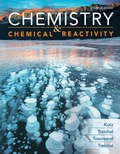
(a)
Interpretation:
The rate law has to be determined for the given reaction.
Concept introduction:
Rate law: It is an equation that related to the dependence of the
For a reaction,
Where,
A and B are reactants
a and b are
Where,
k is the rate constant
Rate constant: Rate constant is an expression used to relate the rate of a reaction to the concentration of reactants participating in the reaction.
(a)
Answer to Problem 78GQ
The rate law for the given reaction is
Explanation of Solution
Given information,
The reaction is
Calculate the value of
Therefore, the rate law of the given reaction is
(b)
Interpretation:
The value of rate has to be determined for the given reaction.
Concept introduction:
Rate law: It is an equation that related to the dependence of the reaction rate on the concentration of each substrate (reactants).
For a reaction,
Where,
A and B are reactants
a and b are stoichiometric coefficients
Where,
k is the rate constant
Rate constant: Rate constant is an expression used to relate the rate of a reaction to the concentration of reactants participating in the reaction.
(b)
Answer to Problem 78GQ
The value of rate constant is
Explanation of Solution
Given information,
The reaction is
Therefore, the rate law of the given reaction is
Calculate the value of rate constant from experiment 1
Therefore, the value of rate constant is
(c)
Interpretation:
The value of rate has to be determined for the given reaction.
Concept introduction:
Rate law: It is an equation that related to the dependence of the reaction rate on the concentration of each substrate (reactants).
For a reaction,
Where,
A and B are reactants
a and b are stoichiometric coefficients
Where,
k is the rate constant
Rate constant: Rate constant is an expression used to relate the rate of a reaction to the concentration of reactants participating in the reaction.
Rate constant for a particular reaction is always constant. It does not depend on the concentration of the reactant.
(c)
Answer to Problem 78GQ
The value of rate constant is
Explanation of Solution
Given information,
The reaction is
Rate constant for a particular reaction is always constant. It does not depend on the concentration of the reactant.
Hence the rate constant of the given reaction is same the rate constant of
Therefore, the value of rate constant is
Want to see more full solutions like this?
Chapter 14 Solutions
Chemistry & Chemical Reactivity
- What constitutes a 'reference material', and why does its utilization play a critical role in the chemical analysis of food products? Provide examples.arrow_forwardExplain what calibration is and why it is essential in relation to food analysis. Provide examples.arrow_forwardThe cobalt mu-hydroxide complex cobaltate(III) of potassium is a dinuclear complex. Correct?arrow_forward
- The cobalt mi-hydroxide complex cobaltate(III) of potassium is a dinuclear complex. Correct?arrow_forward3. Arrange the different acids in Exercise B # 2 from the strongest (1) to the weakest acid (10). 1. 2. (strongest) 3. 4. 5. 6. 7. 8. 9. 10 10. (weakest)arrow_forwardName Section Score Date EXERCISE B pH, pOH, pка, AND PKD CALCULATIONS 1. Complete the following table. Solution [H+] [OH-] PH РОН Nature of Solution A 2 x 10-8 M B 1 x 10-7 M C D 12.3 6.8 2. The following table contains the names, formulas, ka or pka for some common acids. Fill in the blanks in the table. (17 Points) Acid Name Formula Dissociation reaction Ka pka Phosphoric acid H₂PO₁ H3PO4 H++ H₂PO 7.08 x 10-3 Dihydrogen H₂PO H₂PO H+ HPO 6.31 x 10-6 phosphate Hydrogen HPO₁ 12.4 phosphate Carbonic acid H2CO3 Hydrogen HCO 6.35 10.3 carbonate or bicarbonate Acetic acid CH,COOH 4.76 Lactic acid CH₂CHOH- COOH 1.38 x 10 Ammonium NH 5.63 x 10-10 Phenol CH₂OH 1 x 10-10 Protonated form CH3NH3* 3.16 x 10-11 of methylaminearrow_forward
- Imagine an electrochemical cell based on these two half reactions with electrolyte concentrations as given below: Oxidation: Pb(s) → Pb2+(aq, 0.10 M) + 2 e– Reduction: MnO4–(aq, 1.50 M) + 4 H+(aq, 2.0 M) + 3 e– → MnO2(s) + 2 H2O(l) Calculate Ecell (assuming temperature is standard 25 °C).arrow_forward: ☐ + Draw the Fischer projection of the most common naturally-occurring form of aspartate, with the acid group at the top and the side chain at the bottom. Important: be sure your structure shows the molecule as it would exist at physiological pH. Click and drag to start drawing a structure. ✓arrow_forwardFor a silver-silver chloride electrode, the following potentials are observed: E°cell = 0.222 V and E(saturated KCl) = 0.197 V Use this information to find the [Cl–] (technically it’s the activity of Cl– that’s relevant here, but we’ll just call it “concentration” for simplicity) in saturated KCl.arrow_forward
- Chemistry: Matter and ChangeChemistryISBN:9780078746376Author:Dinah Zike, Laurel Dingrando, Nicholas Hainen, Cheryl WistromPublisher:Glencoe/McGraw-Hill School Pub Co
